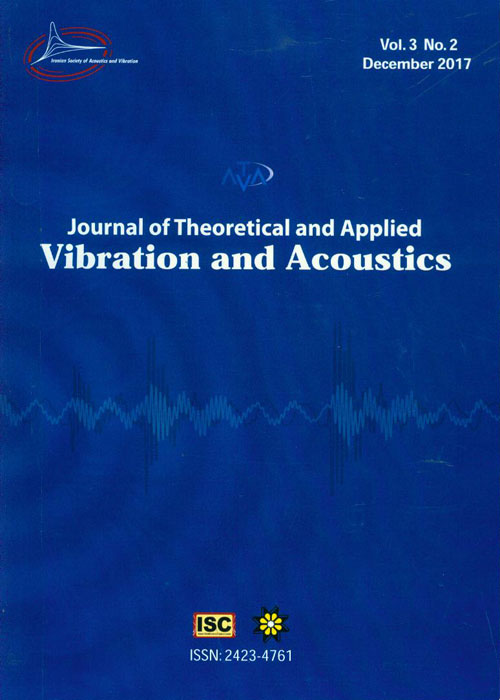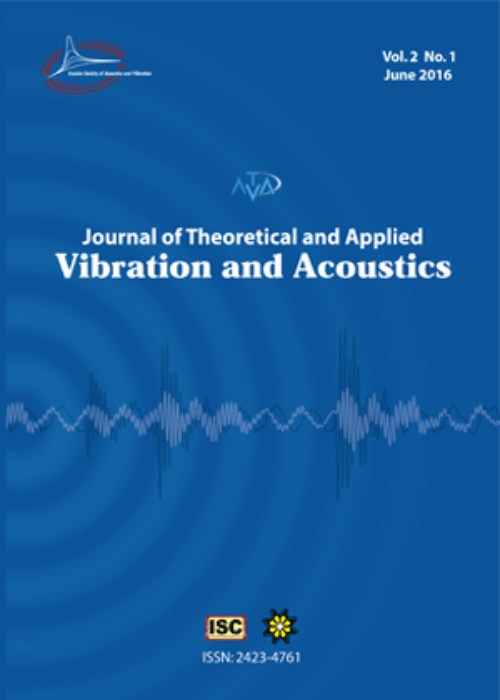فهرست مطالب

Journal of Theoretical and Applied Vibration and Acoustics
Volume:3 Issue: 2, Summer & Autumn 2017
- تاریخ انتشار: 1396/09/30
- تعداد عناوین: 6
-
-
Pages 111-126It is possible to improve vehicle vibration by tuning the parameters of engine mounting system. By optimization of mount characteristics or finding the optimal position of mounts, vibration of the engine and transmitted force from the engine to the chassis can be reduced. This paper examines the optimization of 6-degree-of-freedom engine mounting system based on torque roll axis (TRA) mode decoupling, so that TRA direction coincides with one of the natural modes of vibration. This is achieved by determination of optimal location and stiffness of mounts. In order to find feasible results, physical constraints are taken into account in optimization process. A detailed procedure of optimization problem is explained. Finally, by comparing the frequency and time responses of the optimal design with the original configuration, it is concluded that TRA decoupling is a proper objective function in engine mounting optimization and can greatly improve the vibration behavior of the engine. Achieving decoupled system, the optimal configuration has a better chance of placing dominant natural frequency below the operation range. Also, the forces transmitted through the mounts are reduced noticeably in the optimal design.Keywords: Vibration, Engine mounting system, Torque roll axis, Mode decoupling
-
Pages 127-144Analytical solutions are attractive for parametric studies and consideration of the problems physics. In addition, analytical solutions can be employed as a reference framework for verification of numerical results. In this paper
Homotopy analysis method and Homotopy Pade technique which are approximate analytical methods, are used to obtain nonlinear forced vibration response of Euler-Bernoulli clamped-clamped buckled beam subjected to an axial force and transverse harmonic load for the first time. Analytical solutions for nonlinear frequency are derived via Homotopy analysis method, Homotopy Pade technique and Runge Kutta method and the results are compared with experimental results of literature. Also the time response of the beam is obtained for free and forced vibration via analytical and numerical methods. In addition, the frequency response is drawn. Comparison of analytical results with numerical results and literature results reveals that Homotopy analysis method and Homotopy Pade technique have excellent accuracy for wide range of nonlinear parameters and predict system behavior precisely.Keywords: Nonlinear vibration, forced vibration, Euller, Bernoulli beam, Homotopy analysis method, Homotopy Pade method -
Pages 145-164This paper presents the Fourier and wavelet characterization of vibration problem. To determine the natural frequencies, modal damping and mass participation factors of bars, a rod element is established by means of isogeometric formulation. The non-uniform rational Bezier splines (NURBS) is presented to characterize the geometry and the deformation field in isogeometric analysis (IGA). Non-proportional damping has been used to measure the real-state energy dissipation in vibration. Therefore, the stiffness, damping and mass matrices are derived by the NURBS basis functions. The efficiency and accuracy of the present isogeometric analysis is demonstrated by using classical finite element method (FEM) models and closed-form analytical solutions. The frequency content, modal excitation energy and damping are measured as basis values. Results show that the present isogeometric formulation can determine the modal frequencies and inherent damping in an accurate way. Damping as an inherent characteristics of viscoelastic materials is treated in a realistic way in IGA method using non-proportional form. Based on results, k-refinement technique has enhanced the accuracy convergence with respect to other refinement methods. In addition, the half-power bandwidth method gives modal damping for the IGA solution with appropriate accuracy with respect to FEM. Accuracy difference between quadratic and cubic NURBS is significant in IGA h-refinement.Keywords: Fourier Spectrum, Isogeometric Analysis, NURBS, Wavelet Spectrum, Vibration analysis
-
Pages 165-198In this paper, a size-dependent first-order shear deformation plate model is formulated in the framework of the higher-order generalized nonlocal strain-gradient (GNSG) theory. This model employs two nonlocal parameters and a strain-gradient coefficient to capture the both higher-order nonlocal stress-gradient and strain-gradient effects in nanostructures. The presence of these different scale parameters renders a unified model, which is able to predict both increase and reduction of stiffness in nanoplates. The governing equations are developed for free vibration of first-order shear deformation plates using Ritz method. The dispersion relations for the GNSG plate model is also derived. Several numerical examples are studied to show the efficiency, competence and accuracy of the proposed model. To ensure the applicability of the presented GNSG plate model, the results are compared with the experimental data available in the scientific literature. It is found that the effects of scale parameters on the wave frequencies are significant at high wavenumbers and ratio of any pair of these parameters is the main criterion for the correct study of size effects. The results show that the reduced nonlocal strain-gradient (RNSG) model and the GNSG model diverge in higher vibration modes.Keywords: free vibration, first, order shear deformation plate, wave propagation, higher, order nonlocal strain, gradient model, Ritz method
-
Pages 199-224One of the most important factors influencing the track maintenance is the transitions between parts of the track with different vertical stiffness. The dynamic forces in the super-structure, i.e. from rail to ballast/slab and subgrade, including every layer under ballast/slab until natural ground, are influenced by the type of materials, layer configuration and geometry. One way to mitigate track transition problems is to have a more gradual transition with a reduced stiffness differential. The aim of this research is to reduce vertical transient stresses and displacements under track supports at track transition areas by combining different structural configurations. For this purpose, the train-track dynamic interaction in the transition zones with different vertical stiffness values is analysed using a finite element software. A high-speed train moving on a slab and ballasted track is considered travelling in both directions. The effect of different structural track designs is studied in realistic operation scenarios. The results allow concluding that the sleeper displacements and ballast stresses can be significantly reduced in the transition zones by making small changes in the track structural elements.Keywords: Track design, Transition zones, High, speed rail operations, Sleepers displacement, Track stresses, Finite elements method, Track dynamic behavior
-
Pages 225-240Periodic piezoelectric beams have been used for broadband vibration energy harvesting in recent years. In this paper, a periodic folded piezoelectric beam (PFPB) is introduced. The PFPB has special features that distinguish it from other periodic piezoelectric beams. The Adomian decomposition method (ADM) is used to calculate the first two band gaps and twelve natural frequencies of the PFPB. Results show that this periodic beam has wide band gaps at low frequency ranges and the band gaps are close to each other. Results also show that the PFPB can efficiently generate voltage from the localized vibration energy over the band gaps. The natural frequencies of the PFPB are close to each other and most of them are out of the band gaps. Therefore, the PFPB can also generate the maximum voltage over a relatively wide frequency range out of the band gaps. In order to show these features better, the voltage output of the PFPB over a wide frequency range is calculated using the ANSYS software and compared with that of a conventional piezoelectric energy harvester. The ANSYS is also used to validate the analytical results and good agreement is found.Keywords: Vibration energy harvesting, Periodic folded piezoelectric beam, Vibration Band gap, Adomian decomposition method, Finite element simulation


